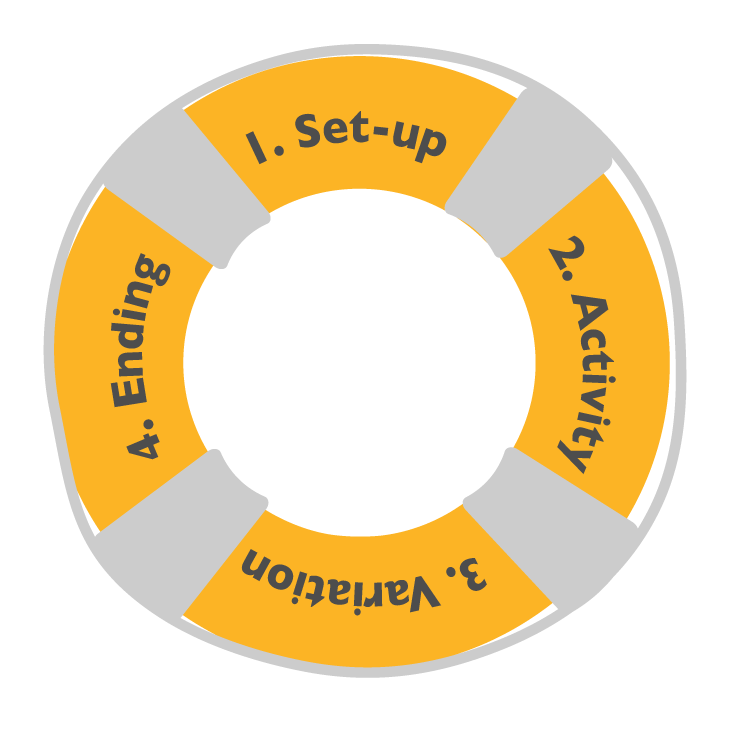
Teaching Your Child a Mealtime Routine
Teaching Your Child a Mealtime Routine
For many parents, mealtime is one of the biggest stressors when raising children. When meals are a source of conflict, the struggle seems to never end: coming to the table, eating what’s served, trying new or undesired foods, and finishing their meal requires far more of your energy than you can afford to give.

We want to S.A.V.E. you the pain and frustration that comes with struggling day-in and day-out with mealtime. The four steps of our S.A.V.E. approach allow you to make teaching your child a mealtime routine practical and approachable. This blog post will focus primarily on two — the set-up and variation — to support you as you try to introduce new foods and have a more peaceful time at the table together.
Set-up
The first step is the set-up, or opening, of the activity. This is where you lay the groundwork for a successful activity and get your child motivated to participate. Below are seven tips for setting up mealtime for success.
BE CONSISTENT
Serve meals and snacks at about the same times every day. Your child will begin to naturally feel hungry at these times. Also, pay attention to what your child is eating before the meal. If they’ve been filling up on snacks, they’re not likely to be hungry and more likely to be picky.
Start off right
Getting your child to the table without drama will set the tone for the meal. Think about how much you are asking of them from their point of view. Are they playing their favorite game and need to stop? Have they just gotten out of the car after a long drive and you need them to sit down again? Consider what might help them transition.
To make these transitions easier, give them 15 minutes to play and set a timer. Another favorite strategy is to offer choices — this helps kids feel like they have some control over their situation (Do you want to sit at the table or the kitchen island? Booster or high chair?).
Be prepared
Having everything ready when your child comes to the table will lessen their chances of getting out of their chair or complaining before you even get settled. We know how challenging this is, and we certainly don’t have everything ready for every meal, but we also know what a difference it makes when we do. When everything is set up and we can sit down together and be totally present, our chances of a successful meal are exponentially higher.
Think outside the meal
Let children have as much involvement as possible in planning, shopping, and preparing the meal. Find what your child likes to do and include them in the process. Your picky eater may be a lot more interested in trying something new if they’ve had a hand in putting it together.
Minimize distractions
Turn off the television and other electronic gadgets during meals. This will help your child focus on eating. Keep in mind that television advertising might also encourage your child to desire sugary or less nutritious foods.
use cues
For a smooth transition, it’s helpful to use the same cue every time before you sit down for a meal. This signals the end of one activity and beginning of another. For example, you can give a 5 minute warning and then wash hands/choose a placemat/say grace/play music.This would sound something like, “5 minutes and then wash hands.” Your child will begin to understand that when they hear the cue, it’s the beginning of the mealtime routine.
Consider positioning
How your child sits has a huge impact on the success of a meal. Children should be sitting with their hips, knees, and ankles all bent at 90 degrees. Correct positioning can take care of the wiggles and help children focus on their meal.
Activity
After you’ve laid the groundwork for a successful meal, the next step is the actual act of sitting down and eating, which is called the routine or activity.
Variation
In this article, we pay special attention to strategies for varying the activity. Here are nine ideas for maintaining their buy-in and introducing new foods.
Be creative
Some kids may be put off by the texture or appearance of certain foods. Making food look appealing to your child is important when getting them to try new dishes. This can involve changing up a recipe (steamed carrots to pureed carrots) or presenting a food differently (sandwich cut in triangles, silly faces on the plate).
Make it taste good
Bland is not better. Between steaming, baking, sautéing, and more, one preparation style is bound to taste best to your child. Spices, sauces, and dips also can make foods taste more appealing. Use them in moderation but recognize their potential to enhance taste.
Play to their strengths
Little kids love any opportunity to show how strong they are, so play into that when you’re talking about food. Remind them that veggies give them power. Maybe you can even give your foods quirky nicknames — “X-Ray Vision Carrots” are much more likely to intrigue your child than plain old “carrots.”
Be patient
Multiple exposures to new foods will help a child become familiar and more comfortable with that food. Exposure doesn’t have to be eating the food. You can start by looking at books or pictures of food and trying pretend play with plastic food. You can paint using apples or make stamps out of celery. Teach your child about fruits and vegetables by cutting them apart and talking about a food’s color, shape, aroma and texture — not whether it tastes good.
Set Realistic Expectations
Interacting with foods at the table doesn’t always mean trying them. Children can sit at a table with a new food or have it on their plate. Encourage them to touch or smell it without the expectation of eating it. Introducing a new food can start by just having a child tolerate it on their plate. After they do that, move to kissing the food, licking the food, and finally biting the food. Then the bite requirement can increase over time. The goal is to start very small and gradually get your child to take bigger bites until you reach an age-appropriate bite size.
Start small
When trying new foods, smaller is better. Only put what you want them to eat on the plate. Giving children large portions or too many options can overwhelm them and cause them to refuse the food outright.
Select smart
Select a food that: is easy to chew and swallow, is similar to a dish they like, has health benefits, and your family eats and will often have in the house. Avoid foods that are tough to chew or have strong tastes, odors, or textures your child doesn’t like. Teaching a child to tolerate texture may require more intensive intervention.
Pair foods
Serve new foods along with your child’s favorite foods. Start with a large amount of the preferred food and a small amount of the novel food and gradually fade the preferred food and increase the amount of novel food. This fading is simple and less likely to start a fight than completely taking away their dinner staple all at once.
Praise
If your child tries a new food, praise them! If you told them one bite, stop at one bite and do something special that will encourage them to try new foods (or more of this one) in the future. Don’t push for more unless they ask for more. You want to allow a clear path to success that you can build on later.
Ending
Finally, aim to end your meal on a positive note and transition successfully to the next activity. Keep meals between 10-30 minutes — going longer can create the wiggles and lead to unnecessary trouble. After you finish eating, find ways to engage your child in cleaning up, this helps them to develop independence and build skills they’ll need as they get older.
Mealtime Routines: What to Remember
Here are some takeaways for creating effective mealtime routines with your child:
- Be consistent with your routine.
- Anticipate when a power struggle may happen and plan to avoid it.
- Involve your child in choosing and cooking the food.
- Eat together in a non-distracted environment to encourage interactions with food.
- When trying new foods, smaller is better.
- If at first you don’t succeed or a new mealtime challenge arises, try and try again.
- Appeal to their imagination to make eating engaging.
- Be playful and have fun!
Thanks for reading the second installment in our series on daily routines. If you want to learn even more, check out our previous blog on dressing and grooming.

Sorry, the comment form is closed at this time.